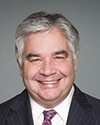Xaada 'láa isis....
There's a reverb here. I'm going to turn my end down. Can you still hear me?
Okay, great.
[Witness speaks in Haida]
Good people, háw'aa for inviting me to speak today.
My name is Jisgang. My English name is Nika Collison. I'm the executive director of the Haida Gwaii Museum, a position I've only recently taken on. Before this, I worked here for 18 years as a curator and senior negotiator for Haida repatriation initiatives, among other things. Until we can secure proper funding, I continue to carry this work along with my new role.
I've been invited to share experiences on the Haida Gwaii Museum, its history and current existence, and the challenges we face. In this, I'd like to begin by saying our museum might be one of the earliest calls to action in regard to reconciliation in the museum and greater world, in that its formation was a vision of both Haida citizens and our friends residing on Haida Gwaii. The museum opened in 1976 at Kay Llnagaay, an ancient Haida village from which I'm presenting right now, and of course we're on Haida Gwaii.
Since almost all of our treasures left the islands during the height of colonization, we didn't have much of a collection to begin with, but several families, both Haida and settler, donated their treasures so they can be cared for and shared by all. One of the earliest acts of repatriation in Canada also occurred through the formation of our museum when then curator Peter Macnair of the Royal British Columbia Museum showed support by returning some monumental poles taken from Haida Gwaii in the early 1900s.
The Haida Gwaii Museum has since grown to include a considerable collection of treasures obtained through donations, commissions, long-term loans, and repatriation and by purchases and really large donations made possible through Canada's Cultural Property Export and Import Act.
In 2008, our museum grew from 5,600 square feet to 17,000 square feet with the creation of the Haida Heritage Centre at Kay Llnagaay, a 50,000 square foot complex of which our museum is a partner, along with the Skidegate Band Council and Parks Canada. Conceptualized and driven by our community, the centre houses several cultural and educational spaces and organizations in addition to our museum. It took seven years and almost $30 million to create.
Throughout, every experience, word, object, and image has been developed with our people ensuring we say what we want to say and how we want to say it. Amongst it all is a grave house that was built to house ancestral remains unearthed during construction of the Haida Heritage Centre. It also serves as a holding place for repatriated ancestral remains awaiting reinterment.
In the 1990s, the repatriation of ancestral remains became a primary focus of our people and has been facilitated and supported by our museum, in partnership with the Haida Repatriation Committee and Council of the Haida Nation since the movement began. To date, more than 500 of our ancestors have been brought home and reburied, from museums, universities, and private individuals across North America and one from overseas. This work has taken over 20 years and has cost over $1 million in cash, sweat labour, and in-kind donations.
We are a category A museum, meaning we meet professional Canadian museum standards by way of facilities and the ability to care for and present our multiple historic collections and archives. We also present new works, as we are a living culture.
Our museum's principle research, collecting, and presentation focus is the recovery of art, knowledge, and documentation pertinent to Haida history located in institutions around the world. This is brought forward into our living culture today. Our mandate is also very focused on the preservation and continuation of the Haida language, an endangered linguistic isolate. We also collect and conduct research on the natural sciences of Haida Gwaii and its history of Canadian settlement.
We conduct all our work in consultation with the Haida and greater islands community, and we approach this work locally and abroad with the goal of mutual respect, co-operation, and trust. We are the main generator of public programs on-island with an annual arts and culture program featuring workshops, art exhibitions, educational programs, and a series of public programs also aimed at visitors to Haida Gwaii.
Other programming includes an array of ongoing community-driven research projects, educational experiences, and other collaborations with organizations both locally and on a global scale. We are also committed to building capacity in the fields of art and heritage by mentoring Haida and other islands in museum practices and arts administration.
These opportunities build important skills for employment and passion and provide unparalleled access to learning about historic and contemporary Haida language, art, and culture, Haida Gwaii itself, and our shared history with Canada. We also operate a gift shop that supports and promotes local artists. In observing the many facets of our operations, it is clear that the Haida Gwaii Museum is not an institution in and of itself; rather, we are part of the institution that makes up Haida society and Canadian society. Together with the Haida Heritage Centre, we provide space, support, and opportunity for artistic and cultural practices, ceremonies, research, education, capacity building, and so on.
We are driven by the community, as I said earlier, and are a part of and contribute to our Haida way of life, an islander way of life, both inside and outside of our house. We have been blazing paths towards reconciliation long before the term became popular.
I will segue into our challenges, and then we'll be touching on each subject in anticipation of providing you with further pertinent information in response to your questions.
Of course, the number one issue or challenge is funding. In order to run a professional small-to-medium sized museum of our stature, at the bare minimum we require professional staff to serve in administration, curation, repatriation, collections, archives, retail, and, ideally, education.
With an absolute basic operating budget, meaning no major exhibitions, publications, research projects, mentorship programs, education programs, etc., thus a very basic annual schedule of programming, our budget runs just over $400,000. Ideally, it would be around $750,000. Based on revenue from existing annual operating grants, admissions, and retail sales, in order to break even, we can only employ myself, a bookkeeper, and a gift shop manager. In this case, our payroll expenses make up about 25% of our operating costs. All other positions are grant dependent, and when we do find grant money for additional positions, all staff are still grossly underpaid.
I'd like to give you some personal examples. As executive director, visual arts curator, repatriation negotiator, facilitator, and marketer, I make $60,000 a year. When I was everything except the executive director, I made $32,000 a year. Our curator of collections and archeology, who is also our conservator and exhibitions preparator, makes $35,000 a year. The archives and gift shop each make $42,000 a year, and remember, many of these positions are grant dependent.
Human resource and capacity building is huge. We're absolutely overworked, underpaid, and underdeveloped. The indigenization, decolonization of museums and, by extension, Canadian society by way of repatriation, reparation, reconciliation, and recognition of indigenous scholarships, laws, and protocol.... Amazing work has been accomplished by working together. I can tell you many stories that demonstrate the miles and miles we have yet to cover. We really need to embrace the TRC calls to action and UNDRIP in this round.
The rural location is very much a challenge. There is an increased cost to living on an island, and because of that, we have fewer visits and less opportunity for revenue generation and grants. However you support art, culture, and reconciliation in general by way of this inquiry, I highly value your understanding of the essentiality that this brings to the sustaining of a healthy economy and society for all and support one of the most powerful on-the-ground roads to reconciliation.
Háw'aa.



